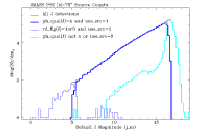
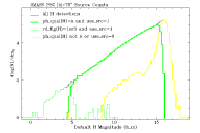
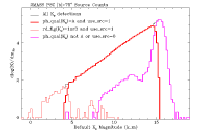
i. Composite Nature of the PSC
The 2MASS PSC is a composite release that is comprised of two
subsets contained in a single database. The first part is
the signal to noise ratio (SNR) >10, high reliability Catalog
that meets or surpasses all of the Level 1
Requirements for sensitivity, uniformity and reliability in
unconfused regions of the sky. Very bright stars that saturate the shortest
2MASS exposures are included in this set even though they do not satisfy
the photometric accuracy requirements. The second component of the PSC is
a faint extension that contains sources that reach 0.5-1.0 mag beyond
J<15.8, H<15.1 and
Ks<14.3 mag levels, where the PSC
is >99% complete. The completeness,
reliability and uniformity of the faint extension
sources are not as good as the high-reliability Catalog
subset of the PSC, and may not satisfy all of the
specifications described in the
2MASS Level 1 Requirements.
They are included in the PSC because, when used with some care,
they can be a valuable resource for certain classes of investigations
in which homogeneous, statistical datasets are not necessary.
Sources are included in the PSC if they have a SNR>7 detection
in at least one band, or have SNR>5 and are detected in all three 2MASS bands.
Sources in the high reliability Catalog meet the
following band-by-band criteria:
where ph_qual, rd_flg
and use_src are
quality parameters that accompany each source record in the
PSC and are described in subsections iii
and xiv below.
Criterion 1 specifies that a source must have a
flux measurement with signal to noise ratio (SNR) >10
or it must be brighter than the
detector saturation limits in either the 1.3 s
Read_2-Read_1 or 51 ms Read_1 exposures.
Criterion 2 above refers to sources that
fall within the overlap region between adjacent
Survey Tiles, and which could have been detected
more than once. If the source is multiply-detected, only the apparition that
that falls closest to the center of its respective
Tile is included in the PSC (see V.4).
If a source is not detected in all observations, then it is
still included in the PSC, but is flagged with
use_src="1" only if it lies closer to the center
of its Tile than any of the other Tiles in which it could have been detected.
This requirement ensures the strict detection uniformity of
the Survey.
Table 1 provides a breakdown of the total number of detections,
and the number of sources which satisfy the
high-reliability Catalog criteria by band (b).
For the column labeled "All", the count of high-reliability Catalog
sources includes the total number that satisfy the above criteria
in at least one band.
The high-reliability Catalog and faint extension of the PSC
are illustrated graphically in
Figures 1a,
1b, and
1c
which show the differential J, H and Ks
source counts for ~1.9 million sources in the north and south Galactic Caps
(|b|>75°). Counts for the high SNR, high reliability Catalog
are shown by the blue, green
and red lines in the
J, H and Ks plots, respectively. The
faint extension components are shown by the
cyan, yellow and
magenta lines
in the three plots, respectively. Black lines show the total
source counts in all plots.
The Catalog
component is divided into two regions, distinguished by
the heavy and thin lines in the Figures, that
correspond to the two parts of Criterion 1. The majority of
Catalog sources, denoted by the heavy lines, satisfy all
of the Level 1 Requirements for
the mission, in the absence of confusion.
The bright part of the Catalog, represented by thin lines,
consist primarily of detections of bright stars that saturate
the 51 ms Read_1 exposures (rd_flg="3"), with
a very small contribution of fainter rd_flg="1" sources
which are usually associated with confused regions
(see I.6.b.vi below).
Positions and brightness estimates for the very bright, saturated
stars are now included in the All-Sky PSC (they were not in the Incremental
Release PSC versions). These detections are believed to be
highly complete and reliable, and to have excellent positions,
but the quality of the photometry is relatively poor because of the
saturation.
The Level 1 Requirements
place no specifications on
these sources, and they do not satisfy the photometric accuracy
specification that applies to unsaturated sources.
The faint extension sources, denoted by the
cyan, yellow and
magenta
lines in Figures 1a,
1b, and
1c,
comprise 29.5%, 38.3% and 43.8% of all
J, H and Ks detections in the PSC, respectively. Most
of these sources, which make up the peaks in the distributions
near J~16.5, H~16 and Ks~15.5 mag, have lower photometric accuracy
(ph_qual="B","C" or "D") simply because they are faint.
There is also a population that extends
brightward of these peaks up to the approximate levels at which
1.3 s "Read_2-Read_1" exposures saturate (J~9, H~8.5 and Ks~8 mag).
These objects, which constitute about 1% of all PSC sources over this
brightness range, are cases where the measurement accuracy is
degraded because of confusion with other sources or other artifacts.
Section II.2.b describes further
the composite nature of the PSC, and contains tips and
guidelines on how to select samples appropriate to address a
variety of scientific investigations.
Name Criteria N(J) N(H) N(Ks) All
Full PSC rd_flg[b]!="0" 455371014 436797138 375248502 470992970
High Reliability Catalog (ph_qual[b]="A" OR rd_flg[b]="1" OR rd_flg[b]="3") AND use_src="1" 321117915 269533860 210729664 341317908
 |
 |
 |
| Figure 1a | Figure 1b | Figure 1c |
ii. Depth of the PSC
The flux levels reached by the PSC are not uniform across the
sky. At the magnitude limits corresponding to the SNR=10
levels specified by the Level 1 Requirements
(J=15.8, H=15.1 and Ks=14.3 mag),
the completeness of the Survey
is ultimately limited by confusion noise due to astronomical source backgrounds.
At fainter flux levels, the depth of the Survey measurements is governed by
the atmospheric conditions at the time of the observations.
The PSC is >99% complete for J<15.8, H<15.1 and Ks<14.3 mag
across the sky,
except in regions of high source density. This is illustrated in Figures
2,
3, and
4
which show the differential surface density of PSC sources in 0.2 mag wide bins
at these brightness levels in Galactic aitoff projections.
Away from the Galactic Plane and Bulge, the surface density
varies smoothly across the sky. Within +90o of longitude
of the Galactic Center the source counts drop dramatically due to the
influence of confusion noise.
The threshold for source detection used in pipeline processing
is scaled to the point source noise levels estimated from the
zero-sum-filtered Atlas Images
(cf. IV.4.a.ii). This threshold
is sensitive to confusion noise, so the detection depth decreases
with increasing source density. The decrease in sensitivity
can also occur in more isolated regions of high source density,
such as in Tiles that contain large globular clusters (e.g., 47 Tucanae).
Figures
5,
6, and
7,
show the differential surface density of PSC sources one magnitude
fainter than the nominal SNR=10 brightness levels. These will
be characteristic of the faint extension of the PSC.
At these flux levels, the density of extracted PSC sources
varies on spatial scales corresponding to the Survey Tiles
(III.2b).
These variations are caused by the influence on survey depth
by atmospheric transparency, seeing and emissive backgrounds,
which could change from scan-to-scan during the Survey.
The zone of incompleteness in the Galactic Plane and Bulge
is also correspondingly larger at these fainter magnitude limits.
The completeness and depth of the PSC as a function
of brightness is discussed in more detail in
VI.7a.
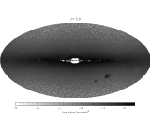 |
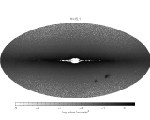 |
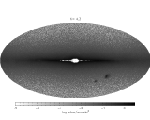 |
Figure 2 | Figure 3 | Figure 4 |
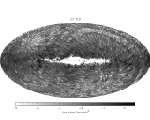 |
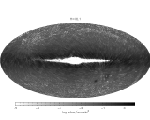 |
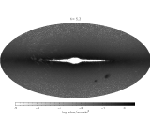 |
Figure 5 | Figure 6 | Figure 7 |
iii. The Default Magnitude
Point source photometry is measured differently for three
brightness regimes in the PSC. The J, H and Ks default
magnitudes (j_m, h_m, k_m) listed for each object represent
what are the best available measurements in each band, as determined
by the automated processing.
The rd_flg
specifies the origin of the default magnitude in each band.
Because different algorithms are
used for each regime, and various normalizations are used to
tie the photometry in each brightness interval together, photometric biases
can occur between them. These biases are discussed
in subsection vii below.
The majority of sources in the PSC have brightnesses below the saturation
threshold of the 1.3 s "Read 2-Read 1" (R_2-R_1) exposures.
R_2-R_1 saturation occurs near J~9, H~8.5 and Ks~8 mag, but
can vary by up to ~0.5 mag depending on the atmospheric transparency and
seeing, and the location of a source relative to pixel centers.
Most default magnitudes for non-saturated R_2-R_1 sources in the PSC
are measured using profile-fit photometry (see
IV.4b) performed
simultaneously on all six individual 1.3 s R_2-R_1 exposures
covering the source. These sources have rd_flg=2 in the
appropriate bands. The profile-fit photometry is normalized
to curve-of-growth-corrected aperture photometry (see
IV.4c), which is also measured for non-saturated
R_2-R_1 sources. The aperture photometry is supplied
in the j_m_stdap, h_m_stdap and k_m_stdap fields
of the PSC for non-saturated R_2-R_1 sources.
Occasionally, the profile-fitting photometry routines fail for
sources in crowded environments or that lie in regions
with complex backgrounds. If an aperture magnitude
is available, it will be listed in the default magnitude field in
the appropriate band, and the rd_flg=4 in the affected bands.
However, these magnitudes are highly uncertain due to the confused
environment.
In a small number of cases, both profile-fitting and aperture
photometry fail to return a valid measurement for detections
made on the R_2-R_1 exposures. In such cases, the default magnitude
is null and rd_flg=9
in the affected band, indicating there is technically a detection at that
position, but no useful measurement can be made. In practice,
this occurs in confused environments.
Sources brighter than J~9, H~8.5 and Ks~8 mag will saturate
in the 1.3 s R_2-R_1 exposures. Up to brightnesses of J~4.5, H~4 and
Ks~3.5 mag, these sources are non-saturated on the short 51 ms
"Read 1" (R_1) exposures. The default magnitudes for such sources are
measured using aperture photometry (see IV.4c)
on the R_1 exposures, and rd_flg=1 in the appropriate band.
If a source is detected on the R_1 exposures,
but the aperture photometry is unable to extract a valid measurement,
then the default magnitude
is null and rd_flg=9 in the affected band.
As for faint sources, this often occurs in confused environments.
The northern observatory Ks detector exhibited
very high noise levels in its central column in data taken
prior to 1997 December 25 UT (an update to the northern camera
controller electronics solved this problem). This
noisy column was masked off, so
detections that fell on or near the column often
had failed measurements
(see III.1b).
Such sources will have good photometry in J and H, but a detection
with no valid measurement in Ks.
Stars brighter than approximately J~4.5, H~4 and
Ks~3.5 mag saturate even the 51 ms exposures.
A new feature of the 2MASS All-Sky Release PSC is that
brightness and accurate position estimates derived directly from
2MASS data are now provided for very bright stars. Photometry for saturated R_1
stars is performed using a 1-d radial profile fit to the azimuthally-averaged
image profile on the R_1 exposures, and
the rd_flg value for the appropriate band is "3".
If a R_1-saturated source is detected, but
the 1-d radial profile fit is unable to extract a valid brightness estimate,
the default magnitude
is null and rd_flg=9
in the affected band.
As with non-saturated R_1 sources, this occurs when sources fall in
confused environments, or when they fall on the masked
central column of the northern Ks array
(see III.1b).
iv. Origin and Quality of Photometry - PSC Quality Flags
The origin and general quality of the default magnitude photometry
listed in the PSC are summarized by a number of
informative flags that accompany each source.
It is essential that users refer to these flags
when interpreting photometry for any source in the Catalog.
The primary quality indicator flags include rd_flg,
ph_qual, cc_flg and
bl_flg. Each of these is comprised of three
characters, each
corresponding to one band; the first character is the J-band value,
the second is the H value, and the third is the Ks value.
The rd_flg denotes the origin of
and algorithm used to derive the quoted default magnitudes for each
2MASS Point Source. Table 2 contains the possible values of
rd_flg, their interpretation and the number of instances
of each value in each band in the PSC.
The cc_flg values identify sources that are believed to be real
astrophysical sources, but whose detection and/or measurement
are contaminated by proximity to
either image artifacts caused by bright stars or nearby sources of
equal or greater brightness. Photometry
in a band for any source that contains a cc_flg value other than "0"
may be corrupted and/or biased by the nearby artifacts or stars.
Users should select sources with cc_flg="000" if
they need samples of sources that have the lowest probability
of contamination.
The algorithms used to identify confused and/or contaminated
sources and to set the values of the cc_flg are discussed
in IV.7. The sources of contamination
encoded in the cc_flg are summarized below.
NICMOS3 detector material produces a latent image
after exposure to a bright source which fades over
a timescale of order 10 sec. This persistence
effect produces a trail of spurious sources in the
wake of a bright star at exactly the 2MASS frame
spacing. Since the position and relative brightness of these artifacts
are well known, detections associated with them are identified
during data processing.
Because a real source can lie under one of these
after-images, candidate latent images are flagged with a "probability
of persistence" that is derived using a chi-squared probability
distribution defined by the predicted position and brightness of
the latent image (cf. IV.7.ii).
The probability distribution was normalized such that
sources with persistence probabilities >50% are believed to be
spurious latent image detections, and those with
probabilities between 10% and 50% are believed to be real
sources that may be contaminated by proximity to the
latent images.
Detections with persistence probability >50% were excluded
from the PSC.
Sources with persistence probability
between 10% and 50% are indicated with cc_flg="p" in
the appropriate band.
Bright stars effectively mask out regions of the sky to fainter source
detection because of the intensity in the wings of their point spread
function. These bright wings often cause spurious detections, so
sources lying within a magnitude-dependent circular region around
bright stars are flagged as confusion artifacts, and
are not passed to the PSC if they are below a specified brightness
relative to the "parent" bright star.
Objects brighter than this threshold remain in the PSC, but
are flagged with cc_flg="c" in the appropriate band(s)
to indicate possible measurement contamination.
Section IV.7.v contains a description
of the magnitude-dependent terms used for this process.
Point sources that lie close to another source of equal or greater
brightness may suffer some bias in its photometry because of gradients
in the underlying background produced by the nearby source.
The degree of bias is a function of the magnitude difference between
the sources and their separation. Sources for which the
bias is believed to exceed 5% are also marked with cc_flg="c" value
in the appropriate band. The magnitude-separation relationships used
to identify sources with this potential photometric confusion
are presented in Section IV.7.vi.
A related parameter in the PSC that is useful for identifying sources
that may be affected by confusion is the prox value which
gives the separation (in arcsec) between each source and its nearest
neighbor in the catalog.
Diffraction spikes from bright stars can trigger false
detections or contaminate the measured flux for a real source
that falls on or near them.
Sources believed to be false detections triggered by diffraction spikes
were not passed to the PSC. Sources believed to
be real, but which may have photometry contaminated by diffraction
spikes, have cc_flg="d". The algorithms used to identify
sources confused and contaminated by diffraction spikes are described
in Section IV.7.i.
Low frequency cross-talk in the 2MASS camera read-out electronics
resulted in bright stars producing an "echo" that was manifested
as horizontal "stripes" in the image frames offset from the
star by +128 camera pixels (256 arcsec). These
stripe artifacts are usually of quite low surface brightness
and so did not trigger many spurious detections. However, they
can contaminate the measurements of sources falling on or near
them. Therefore, such sources are flagged with cc_flg="s"
in the PSC. The algorithm used to identify sources affected by
the stripes is described in Section IV.7.iv.
Source detection and characterization is conducted separately in
the J, H and Ks bands
during the processing of each Survey scan. The detections from each band are
then positionally "merged" into single source records containing
the cross-band information (cf. IV.4.e).
Because the band-to-band instrumental position offsets for the 2MASS
cameras are stable and well-characterized, the bandmerging process is
usually unambiguous. However, in regions of very high source density,
or in instances were a source is split in one band and not others
(i.e., for close double stars), then
the source is flagged with cc_flg="b"
indicating possible confusion in the bandmerging process.
Sources so indicated are usually in confused environments,
and can have aberrant colors because of an incorrect
matching of flux levels between bands. The possible values of the cc_flg,
the conditions they indicate, and the number of sources in each
band having those cc_flg values in the PSC are summarized
in Table 4 below. Sources that
are affected by more than one of the contamination conditions
have cc_flg set in the priority shown by the order of
the values in the table. For example,
a source that is identified as both contaminated by proximity to
a latent image and a diffraction spike from a nearby bright star
will have cc_flg="p" in the affected bands.
The blend flag (bl_flg) included with each point source record
indicates the number of detections or source components measured
simultaneously during the photometric measurement process.
For aperture photometry (rd_flg="1","4") and
1-d radial profile fitting of saturated stars (rd_flg="3"),
the bl_flg value is always "1", since these measurements
did not attempt to deal with blended sources in any way.
For the profile-fitting photometry of non-saturated Read_2-Read_1 sources
(rd_flg="2"), if two or more detections fell within approximately
5´´--6´´,
multiple PSFs were fit simultaneously to the ensemble of detections
to compensate for the overlapping source profiles.
Sources that have bl_flg values >1 are in confused
environments, and have poorer photometric accuracy than
do isolated sources of similar brightness (bl_flg="1").
Most deblended sources will also be flagged with cc_flg="c"
in the appropriate band, indicating likely photometric degradation
due to confusion. To select sources with the highest photometric
accuracy, users should select those with bl_flg Source deblending during the profile-fitting photometry was
triggered only if multiple detections with small separations were
passed to the photometry routines. Close multiple sources that
triggered only one detection were not split into multiple sources,
even if the Table 5 contains the possible values bl_flg for
sources in the PSC, and the number of sources in each band that have each
value. The vast majority of PSC sources are fit with single components
(bl_flg="1"). The maximum number of components fit to any source
in the PSC is 7.
Figure 8 shows an example of
a deblended close triple source in the PSC. Some of the attributes
of each source are listed in Table 6. The central, brightest
component of the triple, 2MASS J22061452+5345303, is blended with
both other components of the triple, so was fit with
three PSFs simultaneously (bl_flg="333").
The other two components, 2MASS J22061426+5345345 and 2MASS J22061487+5345253,
were each blended with 2MASS J22061452+5345303, so they
were each fit simultaneously with two PSFs (bl_flg="222").
Multiple sources with separations close to the resolution limit
of 2MASS may not be resolved consistently across all
detected bands. In such cases, the deblended magnitudes will be listed
for each component in the resolved band(s).
In the unresolved bands, the default magnitude
will be the 95% confidence brightness upper limits measured in a 4´´
aperture on the Atlas Image at the location of the source in
the resolved band(s), and rd_flg="6".
An example of this is shown in Figure 9,
which shows the close source pair 2MASS J14352630-2615587 and
2MASS J14352601-2615582 (sep=4.0´´).
A subset of the source information for these stars is shown in Table 7.
Both components of this double were detected in the Ks band,
and fit simultaneously during the profile-fitting procedure.
The double was not resolved in the J and H bands, even though
the image is clearly extended in those bands.
Thus, the source listings for these two stars show deblended
profile-fit measurements (rd_flg="2" and bl_flg="2") in the
Ks band, and inconsistent deblend upper limits
(rd_flg="6" and bl_flg="0") in the J and H bands.
The upper limits given in the J and H bands capture much of the
flux from two components, though, so contain useful photometric
information. Inconsistent deblend upper limits (rd_flg="6")
should not be confused with non-detection upper limits (rd_flg="0").
Non-Saturated "Read 2-Read 1" (J>9, H>8.5, Ks>8 mag)
Non-Saturated "Read 1" (4.5<J<9, 4<H<8.5, 3.5<Ks8 mag)
Saturated "Read 1" (J<4.5, H<4, Ks<3.5 mag)
rd_flg - Origin of Point Source Photometry
Table 2 - Definition of rd_flg and Occurrences in the PSC
(1 per band)N(J) N(H) N(Ks)
Not detected in this band. The default
magnitude is a 95% confidence upper limit derived from a 4´´
radius aperture
measurement taken at the position of the source on the Atlas Image. The
sky background is estimated in an annular region with inner radius of 14´´
and outer radius of 20´´. The uncertainty in the
default magnitude, [jhk]_cmsig, is null in these cases.
15621956 34195832 95744468
R_1 aperture photometry. The default magnitude
is derived from aperture photometry (IV.4a.i)
measurements
on the 51 ms R_1 exposures. The aperture radius is 4´´, with the sky
background measured in an annulus with an inner radius of 14´´ and
an outer radius of 20´´. The photometric uncertainty
in these cases is the RMS variation of the measured flux from all
frames on which a source falls. If the source was measured on only
one frame, the [jhk]_cmsig value becomes a flag, and has
a value of >8.0 mag in the appropriate band.
1256974 2080493 1840686
R_2-R_1 profile-fit photometry. The default
magnitude is derived from a profile-fitting measurement
(IV.4b)
made on the 1.3 s R_2 exposures. The profile-fit
magnitudes are normalized to curve-of-growth-corrected aperture
magnitudes. The uncertainty for the profile-fit measurements,
[jhk]_cmsig, are derived from a goodness-of-fit metric that
includes terms for uncertainties in the photon noise in the sky
background reference, the noise in the source brightness, and
the how well the fitted profile matches the actual point-spread-function
of the source.
447910694 426256434 360945591
Saturated in R_1. The default mag derived
from 1-d radial profile fit to star image made on the 51 ms R_1
frames. The photometric uncertainty
in these cases is the RMS variation of the measured flux from all
frames on which a source falls. If the source was measured on only
one frame, the [jhk]_cmsig value becomes a flag, and has
a value of >8.0 mag in the appropriate band.
18554 26950 24062
R_2-R_1 aperture photometry. The default
magnitude is derived from curve-of-growth-corrected 4´´ radius
aperture photometry measurements (IV.4c)
on the 1.3 s R_2 exposures.
The sky background is measured in an annulus with an inner radius of
14´´ and an outer radius of 20´´.
The photometric uncertainty
in these cases is the RMS variation of the measured flux from all
frames on which a source falls.
2323 1878 2301
Inconsistent deblend. The default magnitude
is the 95% confidence upper limit derived from a 4´´ radius aperture
measurement taken at the position of the source on the Atlas Image.
The sky background is estimated in an annular region with inner radius of
14´´ and outer radius of 20´´. This is used for pairs of
sources
which are detected and resolved in another band, but are detected and
not resolved this band. This differs from a rd_flg="0", because
in this case there is a detection of the source in this band, but it is not
consistently resolved across all bands. The [jhk]_cmsig value
is null for these cases.
6182450 8430977 12434963
Detection at this location, but no useful
brightness measurement possible. The default magnitude and
uncertainty are null in these cases.
This occurs for sources that were nominally detected in this band, but
for which either profile-fitting or aperture photometry could not
return a useful measurement, usually because of
confusion or proximity to image frame edges where a significant
fraction of the measurement aperture or sky annulus falls off the focal plane.
19 406 899 ph_qual - Photometric Quality
The photometric quality flag, ph_qual, provides a concise
guide to the quality of the default point source photometry that is
based on signal to noise ratio, measurement quality, detection
statistics, etc. Sources with
ph_qual="A" in a band, have <10% measurement
uncertainties, and generally meet or surpass all of the
Level 1 Requirements for the Survey
in unconfused areas of the sky, one of the distinguishing
features of sources that make up the high SNR, high-reliability
Catalog subset of the PSC
(see Section i).
Measurement quality decreases
with alphabetically increasing values of ph_qual. The
values of "U" and "X" are reserved for non-detections/inconsistent
deblends or otherwise unmeasurable detections in a band.
The ph_qual value is set in each band according
to the precedence listed in Table 3 below. For example, a measurement
in a band that satisfies the conditions for "X" is not tested for
other conditions. Table 3 also gives the
number of sources in each band that have the corresponding quality value.
Table 3 - Definition of ph_qual and Occurrences in the PSC
(1 per band)N(J) N(H) N(Ks) X There is a detection at this location, but no
useful brightness estimate can be extracted using any algorithm.
rd_flg=9 and default magnitude is null.
19 406 899
U Upper limit on magnitude. Either source is not detected in
this band (rd_flg=0), or it is detected, but not resolved in a
consistent fashion with other bands (rd_flg=6).
A value of ph_qual="U" does not necessarily mean that there
is no flux detected in this band at the location. Whether or not flux
has been detected can be determined from the value of
rd_flg. When rd_flg="0", no flux has been detected.
When rd_flg="6", flux has been detected at the location where the
images in all three bands (JHKs) were not deblended consistently.
21804406 42626809 108179431 F This category includes rd_flg=1 or rd_flg=3
sources where a reliable estimate of the photometric error, [jhk]_cmsig,
could not be determined. The uncertainties reported for these
sources in [jhk]_cmsig and [jhk]_msigcom are flags and have
numeric values >8.0.
1533 3916 7085
E This category includes detections of any brightness
or SNR where: 1) the
goodness-of-fit quality of the profile-fit photometry was very poor
(rd_flg=2 and [jhk]_psf_chi
 10.0);
or 2) where profile-fit photometry did not converge, and an aperture
magnitude is reported (rd_flg=4); or 3) where the number
of frames on which a source was detected was too small in relation
the number of frames in which a detection
was geometrically possible (rd_flg=1 or rd_flg=2).
The
10.0);
or 2) where profile-fit photometry did not converge, and an aperture
magnitude is reported (rd_flg=4); or 3) where the number
of frames on which a source was detected was too small in relation
the number of frames in which a detection
was geometrically possible (rd_flg=1 or rd_flg=2).
The  2 limit results in many
relatively bright (SNR>>10) unresolved double stars being found
in this category.
2 limit results in many
relatively bright (SNR>>10) unresolved double stars being found
in this category. 2376875 3067220 2100224
A Detections in any brightness regime where valid measurements
were made (rd_flg=1,2 or 3) with [jhk]_snr
 10
AND [jhk]_cmsig
10
AND [jhk]_cmsig 0.10857.
0.10857. 321736060 269905059 211009193
B Detections in any brightness regime where valid measurements
were made (rd_flg=1,2 or 3) with [jhk]_snr
 7
AND [jhk]_cmsig
7
AND [jhk]_cmsig 0.15510.
0.15510. 93014634 82796316 60899695
C Detections in any brightness regime where valid measurements
were made (rd_flg=1,2 or 3) with [jhk]_snr
 5
AND [jhk]_cmsig
5
AND [jhk]_cmsig 0.21714.
0.21714. 28268193 58181272 59859408
D Detections in any brightness regime where valid measurements
were made (rd_flg=1,2 or 3) with no [jhk]_snr or [jhk]_cmsig
requirement.
3791250 14411972 28937035
cc_flg - Contamination and Confusion
Table 4 - Definition of cc_flg Values and Occurrences in the PSC
Source is unaffected by artifacts, or source
not detected in that band 375059297 389911797 410775947
Persistence (Latent) Image from Bright Star 2438794 3919008 1550140
Confusion with nearby brighter source 90679500 73584699 54196294
Nearby Diffraction Spike 133283 563982 707105
Horizontal "Stripe" due to Bright Star 2667409 2995595 3740717
Confusion in Bandmerging 14687 17889 22767 bl_flg - Blended Sources
 1
in all three bands.
1
in all three bands.
 2
goodness-of-fit to a single profile was large
(IV.4.b). Thus,
2
goodness-of-fit to a single profile was large
(IV.4.b). Thus,
 2 >> 1.0 for rd_flg="2",
sources may indicate that a source is an unresolved multiple
(N.B.: Large
2 >> 1.0 for rd_flg="2",
sources may indicate that a source is an unresolved multiple
(N.B.: Large  2
values are also characteristics of single, extended sources and
unreliable detections of image artifacts, hot pixels
and meteor trails).
2
values are also characteristics of single, extended sources and
unreliable detections of image artifacts, hot pixels
and meteor trails).
Table 5 - Definition of bl_flg Values and Occurrences in the PSC
N(J) N(H) N(Ks)
Source not detected in that band (rd_flg="0") 21804425 42627215 108180330
Single profile fit to isolated source
(rd_flg="2"), or detection measured with aperture photometry
(rd_flg="1","4") or 1-d radial profile fitting
(rd_flg="3") 423830534 406502420 344169247
Two sources detected in small region and fit
simultaneously during profile-fit photometry (rd_flg="2").
24537688 21024130 17963320
Three sources detected in small region and fit
simultaneously during profile-fit photometry (rd_flg="2").
795238 806744 656531
Four sources detected in small region and fit
simultaneously during profile-fit photometry (rd_flg="2").
24404 31493 22931
Five sources detected in small region and fit
simultaneously during profile-fit photometry (rd_flg="2").
658 945 603
Six sources detected in small region and fit
simultaneously during profile-fit photometry (rd_flg="2").
18 23 8
Seven sources detected in small region and fit
simultaneously during profile-fit photometry (rd_flg="2").
5 0 0 Table 6 - Source attributes for the resolved triple shown in Figure 8
| designation| j_m|j_cmsig| h_m|h_cmsig| k_m|k_cmsig|ph_qual|rd_flg|bl_flg| prox|
| char|double| double|double| double|double| double| char| char| char|doubl|
| | mag| mag| mag| mag| mag| mag| | | |arcse|
22061426+5345345 13.836 0.027 13.595 0.046 13.545 0.052 AAA 222 222 4.7
22061452+5345303 13.320 0.043 12.591 0.051 12.426 0.041 AAA 222 333 4.7
22061487+5345253 14.456 0.042 13.807 0.051 13.721 0.065 AAA 222 222 6.0
Table 7 - Source attributes for the partially resolved double shown in Figure 9
| designation| j_m|j_cmsig| h_m|h_cmsig| k_m|k_cmsig|ph_qual|rd_flg|bl_flg| prox|
| char|double| double|double| double|double| double| char| char| char|doubl|
| | mag| mag| mag| mag| mag| mag| | | |arcse|
14352630-2615587 12.346 null 11.984 null 13.131 0.041 UUA 662 002 4.0
14352601-2615582 11.717 null 11.406 null 11.328 0.035 UUA 662 002 4.0
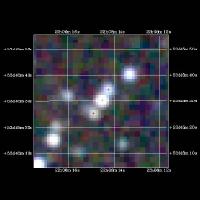 |
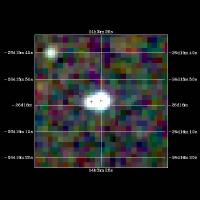 |
| Figure 8 | Figure 9 |
v. Photometric Uncertainties
Three measures of photometric uncertainty are provided for
each 2MASS PSC "default magnitude". The first, [jhk]_cmsig,
are the measurement errors returned by the default photometry algorithm
in J, H and Ks.
For profile-fit photometry (rd_flg="2"), the measurement
uncertainties have been corrected (see IV.4b) to
be consistent with the statistical variation of repeated measurements.
For aperture photometry and 1-d radial profile-fitting of the
saturated R_1 sources, the uncertainties are the RMS variation of
the measured flux from all frames on which a source falls (typically six).
In the latter case, if there are less than two frames available
for the aperture measurements, [jhk]_cmsig becomes
a flag, and has a value >8.0 mag in the appropriate band.
The [jhk]_cmsig values are appropriate when comparing photometry
of sources over small spatial scales (i.e., within a 2MASS Tile).
The second photometric uncertainty quoted in the PSC is
[jhk]_msigcom, which is the root-sum-square (RSS) combination of
[jhk]_cmsig with
the uncertainty in the nightly photometric calibration solution,
the estimated flat-fielding residual (0.005 mag), and, for bright
rd_flg="1" sources, the R_1 photometric normalization uncertainty
(0.012 mag). The [jhk]_msigcom values provide a better
estimate of total photometric errors, useful when comparing
photometry of sources across large spatial regions.
Since error estimation is a statistical process,
faint sources will occasionally have unphysically low measurement errors.
Bright sources can also have unusually large uncertainties
if the photometry process is contaminated by confusion with a nearby
source, masked pixels, or cosmic rays.
For these reasons, measurements in each band are also supplied with the
scan signal to noise ratio
([jhk]_snr)
which are the ratios of the
default flux in each band to the characteristic point source
measurement noise within each Survey Tile.
vi. Sources of Unreliability
Data processing algorithms, quality assurance, and criteria for
generating the 2MASS Catalogs are all designed to produce
highly reliable lists of detections of solar system and astronomical
objects. By reliable, here, we mean that if an observer
conducts a follow-up observation at the position listed for
a 2MASS source, then a source of near-infrared radiation will be
found at that location. This is modulated by proper motion of
the source (which can be significant for solar system objects),
and that the accuracy of the reported flux
will be limited by the brightness and potential confusion of
that source. Even at the strict <0.05% unreliability limits
stipulated by the Level 1 Requirements, though,
the PSC is so large that there may be >170,000 unreliable
sources extant in the high-reliability Catalog subset, and
considerably more in the full PSC.
In this section, we describe the known causes
of unreliable sources in the PSC, and provide tips on how to
identify such "detections" when using the catalog. Confirmed unreliable
sources in the PSC will be maintained in an Anomaly List
(see II.6.g) that will be updated
periodically.
In general, unreliable sources exhibit one or more of the
characteristics described in Table 8. Users should exercise some caution
when encountering such sources. However, possession of any one
or more of these attributes does not necessarily imply that a detection is
unreliable, only that it merits examination.
Scattered-light halos, diffraction spikes, latent images,
and other optical ghosts associated with bright stars
can trigger spurious source detections and contaminate the photometry of
real sources that lie close to them. These spurious detections
and contaminated sources
are identified and flagged (see IV.7),
using geometric algorithms based on the position and brightness of
the "parent" bright star. The spurious detections
are filtered out of the PSC during the Catalog Generation process (see
V.3).
The artifact identification process is
not perfect, however, so a number of bright star artifacts are present
in the PSC. Some of these will be flagged as real
sources contaminated by artifacts (cc_flg="p","c","d","s") in one
or more bands, and others may not.
The residual artifacts occur for several reasons:
An analysis of
residual bright star artifacts in the PSC
has been made, and most are found to be single-band and occasionally
two-band sources with SNR < 10 (i.e., ph_qual !="A"),
and profile-fit photometry values
A special class of bright star confusion "artifact" that
appears in the PSC is the "faint" rd_flg="1" detection.
"Faint", here, means that these sources are fainter than
the nominal R_2-R_1 saturation level of J~9, H~8.5 and Ks~8
mag. These sources usually found in the wings of very
bright stars, and can sometimes be detections of real objects.
The real sources are usually detected
in both the R_1 and R_2-R_1 exposures, but the R_2-R_1 detections
are usually flagged as confusion artifacts and
filtered out of the processing. However, because
R_1 and R_2-R_1 artifact identification was handled slightly differently,
the corresponding R_1 detections of the sources were
not always filtered out. These "faint"
R_1 unreliable sources are usually single band (rd_flg="1" in one
band and rd_flg="0" in two bands) and about 80% of
the occurrences are flagged as being affected by artifacts, having
cc_flg="c","d" or "p" in the detected band.
Most meteor trails were identified and masked during construction of the
2MASS Atlas Images (see IV.3), so
relatively few spurious detections on the trails are present in the PSC.
However, masking of the trails could not be made 100% complete without
compromising survey coverage, and a few trails have
persisted in the images (see I.6.a).
It is estimated that at most a few hundred such detections
may have survived into the PSC. Such sources are usually distinguished
by having a profile-fit photometry value
Insects crawling (see
Anomalies
Gallery) across the camera windows during
2MASS scanning also produce image artifacts that trigger spurious point
source detections. Most scans that were contaminated by insects
were rejected during the quality assurance (QA) process and reobserved,
but a small number were not caught during QA. Insect artifacts are
usually diffuse blobs that are impossible to mistake for point sources,
but that could be mistaken for extended sources on the Atlas Images. Spurious
point source detections, due to insects, are believed to be quite rare
in the PSC (i.e., < 100 occurrences).
A small number of pixels on each of the 2MASS NICMOS 3 detector arrays
exhibited bi-stable behavior, which would toggle between relatively normal
noise and responsivity and an intermittent high-signal, or "hot" state.
Pixels read out when in the hot state often triggered spurious detections
on a succession of frames in a scan. These detections were fixed
on the array, but not on the sky. Thus, they produced what could be
relatively bright single-frame, or "solo" detections.
Most incidents of "hot pixel" events were eliminated during scan
processing using two filters. First, an automated procedure built into
the sky-bias correction step of the instrumental frame correction (see
IV.2) masked pixels that exhibited large variances
in the stack of 42 frames used to generate the bias frame.
Second, a solo-blanking procedure (see IV.4)
identified
bright single-frame detections and filtered them out of the detection
stream that was passed on to later stages of data processing.
Despite these protections, a number of "hot pixel" detections
are known to have passed through these filters and into the extracted
source database. A
detailed report
on the spurious hot pixel detections shows that their characteristics are:
The most egregious hot pixel was one on the southern H-band
array detector that produced ~84,000 spurious detections,
with cross-scan positions in the
range 153 There may still be as many as 100,000 hot pixel detections remaining
in the full PSC, but only ~2500 are in the high
reliability subset of the PSC with ph_qual="A".
Users should be cautious when dealing with single-band PSC sources
with [jhk]_psfchi>2 and ndet[1,3,5]
PSC Sources associated with the predicted position of known asteroids,
comets, planets and planetary satellites have the parameter mp_flg="1".
While these are for the most part good detections and measurements of
these objects, they do not meet the strict definition of source
reliability because they will not be at the reported position in
follow-up observations.
vii. Single-Band Sources
As summarized in II.2.c, the PSC contains
approximately 9.2 million, 1.3 million and 960 thousand single-band
J, H or Ks
sources, respectively. While these sources
are not rare, they should be regarded with some caution
because single-band detections are the least reliable class of source
in the catalog. Single-band sources have rd_flg="0" in
two bands.
At high Galactic latitudes, real, faint J-only sources are not uncommon,
because the 2MASS system is most sensitive in the J-band, and
the intrinsic colors of most stars and galaxies are blue
enough to make them preferentially detectable in J.
Legitimate Ks-only sources are generally associated with
large amounts of intrinsic or foreground dust extinction, and
are usually found close to the Galactic Plane, in molecular clouds,
and in the Magellanic Clouds. H-only detections are extremely difficult
to produce with known astrophysical objects, and are probably the
least reliable sources in the PSC. In principle,
a bona fide H-only detection could be produced by a source with strong
emission lines in the H-bandpass, e.g., a QSO or planetary nebula,
but these are expected to be rare.
Very often single-band detection is a symptom of unreliability, due
either to confusion between sources, spurious detections of image artifacts,
or transient events, such as cosmic ray strikes or hot pixels. Users
are strongly urged to scrutinize single-band sources; examining
their images using the 2MASS
All-Sky Image Server is an excellent way to discriminate between
clean sources and spurious, or confused, detections.
viii. Photometric Biases
The photometry of high SNR/high reliability Catalog subset
of the PSC is demonstrated to be uniform to the ~4% level in each band
over the unconfused sky (cf. VI.1b).
However, there are known to be systematic photometric biases
at levels below this that affect the photometry of sources
in the Catalog over a range of spatial scales. In addition,
a much larger bias is known to exist in the photometry of
stars that saturated the 51 ms "R_1" exposures (rd_flg="3")
that produces a prominent discontinuity in the global PSC source
counts near the R_1 saturation level.
The known sources of bias in the PSC are summarized here.
2MASS photometric uniformity is enforced on the largest scales
by the Survey's photometric calibration strategy
(see III.2.d).
Nightly photometric
transformations are derived from hourly measurements of one
of 35 calibration fields, 12 of which are located on the celestial
equator and are observed from both observatories, often on the
same night. The photometric system is tied between the 2MASS observatories
by referencing all photometry, in part, to measurements of the same
standard stars. The measured mean residual bias between stars observed
from the two observatories on the same night is -0.003, -0.009 and -0.004 mag
in J, H and Ks, respectively, with measurements from
Mt. Hopkins being brighter than those from Cerro Tololo.
Brighter stars show a bias up to ~0.005 mag larger than
fainter stars. The bias also shows a weak variation around the sky,
with the differences being largest in the range
0°<ra<120°.
Brightness estimation for stars that saturated the 51 ms R_1 exposures
is performed using a 1-d radial profile fit to the non-saturated portion
of the azimuthally-averaged image profile on the R_1 exposures
(IV.4.a.iii). In general, the statistical accuracy
of these brightness estimates is ~10--20%, poorer than for non-saturated
point sources. In addition, the photometry of these
stars can exhibit a substantial bias relative to non-saturated
sources because of uncorrected effects of seeing.
The 1-d radial profile fits were made to single
analytical templates, one for each band and observatory,
that were derived from the observations of a relatively small
number of non-variable, bright stars with previously measured brightness.
Photometry derived from fits
made to stars observed under seeing conditions
substantially different from the mean condition of the profile-calibration
stars is systematically biased relative to the calibrators.
The amplitude and sign of the bias is a systematic function of the seeing,
and can be as large as ~0.3 mag. However, the bias is
on average closer to ~0.1 mag in the sense that the
quoted magnitudes are too faint.
The seeing has been characterized to some degree
(cf. this memo).
However, seeing corrections were not applied to the rd_flg="3"
photometry in the PSC because
they always produced stellar colors that showed larger
post-correction dispersions.
The seeing calibration bias produces a substantial discontinuity in
the PSC source counts in the vicinity of the 51 ms R_1 exposure
saturation level because sources are redistributed into
fainter flux bins. Figure 10
shows a section of the source count curve for all PSC J-band detections,
along with the Tycho 2 VT source counts for reference.
The discontinuity seen near J~5 mag is not due to incompleteness
of the PSC. Similar discontinuities can be seen in the H and Ks
source count curves, as can be seen in
Figure 11.
Table 8 - Common Characteristics of Unreliable PSC Sources
Condition Source Attribute
Single band detection rd_flg="0" in two bands
Contamination or confusion flagging cc_flg != "000"
Large value of profile-fit photometry  2 value
2 value rd_flg="2" and [jhk]_psfchi >> 1
Low frame-detection count for SNR>7 sources ndet[1,3,5]  1 and [jhk]_snr >7
1 and [jhk]_snr >7
Read_1 detection that is fainter than the Read_2 saturation limits (rd_flg[1]="1" and j_m>9) or (rd_flg[2]="1" and h_m>8.5) or (rd_flg[3]="1" and k_m>8)
Source is fragment of an extended source gal_contam="2" Source is associated with a solar system object mp_flg="1"
Unflagged Artifacts from Bright Stars
 2 > 2 (i.e., rd_flg="2"
and [jhk]_psfchi >2).
2 > 2 (i.e., rd_flg="2"
and [jhk]_psfchi >2).
Meteor Trails and Other Image Artifacts
 2 > 2 in
one or more bands (rd_flg="2" and [jhk]_psfchi >2),
by being detected in only one of the 6 or 7
2MASS frames that cover each point on the sky (ndet[1,3,5]="1"),
and by having no optical association within 5´´
(i.e., a is null).
2 > 2 in
one or more bands (rd_flg="2" and [jhk]_psfchi >2),
by being detected in only one of the 6 or 7
2MASS frames that cover each point on the sky (ndet[1,3,5]="1"),
and by having no optical association within 5´´
(i.e., a is null).
Hot Pixels
 2 >2 (rd_flg="2" and [jhk]_psfchi>2)
2 >2 (rd_flg="2" and [jhk]_psfchi>2) 10--15
10--15 1 individual frames,
despite having SNR
1 individual frames,
despite having SNR 7
(ndet[1,3,5]
7
(ndet[1,3,5] 1).
1). +x_scan
+x_scan +155,
that would have otherwise been passed onto the PSC. Because ~70,000
of the artifacts from this one pixel would have satisfied the criteria of
the high SNR, high reliability Catalog, more than
14 times as many produced by all of the other
hot pixels combined, these particular hot pixel detections were
removed from the PSC before the Release.
+155,
that would have otherwise been passed onto the PSC. Because ~70,000
of the artifacts from this one pixel would have satisfied the criteria of
the high SNR, high reliability Catalog, more than
14 times as many produced by all of the other
hot pixels combined, these particular hot pixel detections were
removed from the PSC before the Release.
 1.
The Atlas or Quicklook Images of spurious detections caused by hot pixels
do not show an source apparent at the source position.
1.
The Atlas or Quicklook Images of spurious detections caused by hot pixels
do not show an source apparent at the source position.
Solar System Objects
Observatory Bias
Uncorrected Seeing Effects for rd_flg="3" Photometry
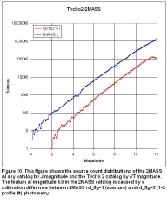 |
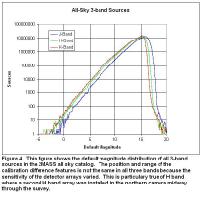 |
| Figure 10 | Figure 11 |
The aperture photometry of sources made on the 51 ms R_1 exposures (rd_flg="1") was normalized to the curve-of-growth-corrected aperture photometry from the 1.3 s R_2-R_1 exposures. The normalization was made by adding a seeing-dependent constant to the R_1 exposure photometry. The seeing-indexed normalization constants were derived for each band at each observatory by computing the mean offsets between the R_1 and R_2-R_1 exposure aperture photometry using stars in the brightness range to be detected on the R_1 exposures and non-saturated on the R_2-R_1 exposures (IV.4.c.i). The standard deviation of the mean offsets in each seeing bin was typically 1--2%. This component of the uncertainty has been factored into the combined photometric uncertainties ([jhk]_msigcom) for rd_flg="1" sources.
The J-band PSC source count curve shown in Figure 10 shows a second, smaller discontinuity at J~9 mag, which is near the R_2-R_1 saturation level, and thus the transition between rd_flg="1" and rd_flg="2" sources. This discontinuity is better seen in Figure 12, which shows the J-band PSC source counts normalized to a power-law. This offset is consistent with a ~1% systematic bias between the R_1 and R_2-R_1 photometric scales. However, we cannot rule out that the PSF-fit normalization table error, described in the next subsection, does not also contribute to this discontinuity by biasing the rd_flg="2" source photometry calibration by ~1-2%.
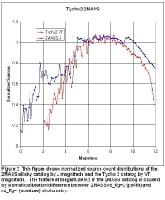 | |
| Figure 12 |
Outdated corrections were used to normalize the profile-fit photometry
to the curve-of-growth-corrected aperture photometry
(IV.4.c) in
high source density regions, where the empirical correction could
not be reliably determined. This resulted in a systematic
overestimate of source brightnesses, the amplitude of which
is a function of seeing FWHM and the photometric band.
The overestimation ranges from <0.01 mag in good seeing, to
a maximum of 0.02--0.03 mag for the worst seeing in the Survey.
Because the amplitude of the bias can be different in each band,
this can produce a residual color-bias on ~15´ scales along
a Tile, and ~8.5´ across Tile boundaries.
This bias is believed to cause at least part of the discrete color jumps
correlated with Atlas Image boundaries, seen
in spatially-averaged color maps of high source density
regions, such as those illustrated in
Figure 13. However, these jumps can be as large as 5%,
so they cannot be fully accounted for by the PSF-normalization errors.
We do not have a complete understanding of the origin
of these color jumps, but they are known to be correlated to
changes in the PSF used in profile-fit photometry. The
biases are not seen in colors derived from aperture photometry.
PSF-Normalization Table Correction
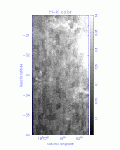 |
| Figure 13 |
The assumed form of the PSF used for profile-fit photometry
(rd_flg="2") was obtained from a table lookup that is indexed by the
seeing shape parameter. The seeing shape parameter
is related to image full-width at half-maximum (FWHM) via the relation:
The
mean seeing shape was estimated at intervals of ~20 sec or longer,
corresponding to the time for the telescope to scan over the length
of approximately one Atlas Image (15´).
Variations between the instantaneous
seeing and the mean value can lead to mismatches between
the adopted PSF and the true image shape. Such mismatches result
in systematic errors in the profile-fit photometry that are
coherent over scales equal to the seeing variation time.
The maximum bias expected from this effect is <0.02 mag,
and it is largest for high SNR sources where the photometric uncertainties
are dominated by PSF-mismatch rather than photon statistics.
The impact of PSF errors is discussed in IV.4b.
The profile-fit photometric algorithm (see IV.4b)
is sensitive to small
variations in the shape of the point-spread-function (PSF) across the
focal plane.
Because the 2MASS optical systems are slightly astigmatic, point
source images become elongated towards the focal plane edges, and there
can be a resulting bias of of the profile-fit photometry
of sources close to scan edges relative to the centers of the scans.
This cross-scan bias is corrected ex post facto during data processing by
normalizing to the aperture photometric measurements of sources
as a function of cross-scan position. Residual cross-scan biases of PSC
sources are measured to be << 1%.
Photometry of sources in close proximity to another source of
equal or greater brightness is biased, due to contamination of the
sky reference annulus by the light from the nearby star. The sense of
the bias is that the source brightness is overestimated, and the
degree of overestimation increases the closer the source falls
to the nearby source.
Sources that are believed to have fluxes overestimated by
Bright stars very near the R_1 saturation levels of
J~4.5, H~4 and Ks~3.5 mag may exhibit a larger
scatter in their photometry
because they were measured on only one or two frames, and therefore
suffer from the effects of intrapixel response variations.
The point source response of the 2MASS detectors has been measured
as a function of sub-pixel position.
Response variations
are small for the northern and southern J and Ks and
original northern H arrays, but can be as large as 0.2 mag for the
southern H-band and the new northern H-band arrays.
Normally, the quoted brightness for
stars in the unsaturated R_1 regime is the
average of the flux measured on six or seven unsaturated frames.
For stars just at the R_1 saturation level, though, the
PSC magnitude is derived from measurements only on those
frames that are unsaturated, and can be taken from as few as one
unsaturated frame (stars saturated on all available frames
have brightnesses estimated differently). The number of frames
used to derive the default magnitudes for
non-saturated PSC sources (rd_flg="1", "2" or "4") is
given in the first, third or fifth fields of the ndet
parameter for each source. Photometry for sources with
rd_flg="1" in J, H or Ks and that have
ndet[1,3,5]<3 is of poorer quality. Such sources
have degraded values of the photometric quality flag, ph_qual="E".
Approximately one million stars in the All-Sky Relase PSC have been found
to have
erroneous J-band photometry. The affected stars fell on the central column of
the J-band array of the Southern hemisphere 2MASS system. Stars that fell on
this column have reported J-band fluxes that are approximately 10% lower than
their actual fluxes and thus 2MASS J-H and J-K colors that are too red.
Queries of the 2MASS All-Sky Release PSC, Survey Point Source Reject Table,
and the 6x and Calibration Point Source Working Databases can avoid/identify
these stars by including the following condition
hemis='s' and dist_edge_ew=251 and (dist_edge_flg='se' or dist_edge_flg='ne').
Examples of this bias and a discussion of its potential impact
are given in VI.9.
ix. General Effects of Confusion
Faint source detection is done by identifying intensity maxima in
the 2MASS Atlas Images that are greater than 3 times the
point-source-filtered noise levels (see
IV.4a for details).
The noise estimator is sensitive to confusion noise, and thus increases in
areas of increasing source density, such as the Galactic Plane.
Thus, the effective depth of the PSC will decrease in regions of
high source density, as is illustrated in Figures 2--4 and 5--7.
The variation of completeness of the PSC as a function
of source density is discussed in Section
VI.7.
In areas of high source density, it is very likely that
an image artifact from a bright source will
fall on top of one or more real sources. The process of
artifact identification (see IV.7)
results in many real sources being filtered
out of the Catalogs, or at least flagged as being affected by artifacts.
This filtering produces outlines of missing sources
that trace the "mask" around bright sources defined by the geometric
parameters used for artifact identification.
This is especially apparent in the cores of globular clusters and
near the Galactic Center.
Close double or multiple sources are not reliably resolved by
2MASS if their angular separation is <6´´. The effective
resolution of the 2MASS system is approximately
5-6´´, and is governed by the camera pixel sizes, image dithering
efficiency, atmospheric seeing and source extraction algorithms.
Figure 14 shows the distribution of
separations for all
source pairs in the PSC out to 16´´ separation. The resolution
limit is reflected in the rapid roll-over for separations <5´´.
There are source pairs with apparent separations well below
this limit. These are invariably associated with blended
sources or sources in complex environments,
where the detections have been split into different Catalog entries
in different bands. Users should treat any source
with a prox value <5--6´´ with some caution.
PSF-Seeing Mismatch
Cross-scan Photometric Bias
Proximity to Sources of Equal or Greater Brightness
 5% are flagged with cc_flg="c" in the
appropriate
band(s) in the PSC (IV.7).
This photometric confusion affects
nearly 50% of sources in the highest source-density regions
of the sky.
5% are flagged with cc_flg="c" in the
appropriate
band(s) in the PSC (IV.7).
This photometric confusion affects
nearly 50% of sources in the highest source-density regions
of the sky.
Stars Near the R_1 Saturation Level
Compromised J-band Photometry for Sources with dist_edge_ew=251E and hemis='s'
Source Detection Thresholds in High Source Density Regions
Artifact Identification Efficiency
Blended Sources
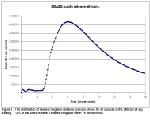 | |
| Figure 14 |
Close multiple sources may trigger numerous detections in a small area that differ from band-to-band, leading to potential confusion in the bandmerging process (IV.4.e). This can lead to the incorrect matching of detections between bands, resulting in unusual source colors. Sources affected by such confusion have cc_flg="b" in the appropriate bands. Photometry in such cases is very likely to be contaminated due to confusion.
Multiple sources with separations near the resolution limit of 2MASS may be resolved in one or two bands, but not necessarily in all detected bands. In such cases of inconsistent resolution or deblending, the sources involved have the measured point source magnitude reported in bands that are resolved, but have 95% confidence upper limits quoted in the bands that are not resolved. The upper limits are derived from aperture measurements made on the Atlas Images, so generally capture most of the flux of the blended sources in the unresolved band(s). Such sources have rd_flg="6" in the unresolved band(s), and usually have bl_flg > 1 in the resolved band(s).
As discussed in above, sources close to objects of equal or greater brightness will have quoted fluxes that are systematically too bright, because of contamination in the sky reference annulus used for photometry. This photometric confusion is produced by stars of all brightnesses, so in regions of high source density, a significant fraction (~50%) of all sources can have biased photometry. Sources with photometry that is believed to be overestimated by >5% are flagged with cc_flg="c" in the affected band(s).
x. Very Bright Stars
Stars brighter than approximately J~4.5, H~4 and
Ks~3.5 mag saturate the 51 ms exposures.
A new feature of the 2MASS All-Sky Release PSC is that
brightness estimates and accurate positions derived directly from
2MASS data are now provided for all bright stars, up to the
brightest near-IR source on the sky, alpha Orionis
(Betelgeuse = 2MASS J05551028+0724255),
which has J=-2.99, H=-4.01 and Ks=-4.38 mag. Thus,
the 2MASS PSC has an effective dynamic range in brightness of nearly
20 magnitudes.
Photometry for saturated R_1 stars is performed using a 1-d radial
profile fit to the non-saturated portion of the azimuthally-averaged
image profile on the R_1 exposures (IV.4a).
The accuracy of this photometry is not as good as for the non-saturated
stars, and the photometric uncertainties listed for these objects
(rd_flg="3") are generally >0.2 mag. Users should
respect these uncertainties.
In addition to having large random uncertainties, the photometry
of saturated R_1 stars can also exhibit biases of up to 0.1--0.2 mag,
because of uncorrected seeing-dependencies in the 1-d profile-fitting
(IV.4a).
The maximum effect of this bias can be ~0.3 mag, but is much smaller
for most stars. The current best estimate of the seeing correction
is discussed in IV.4a.
The uncorrected seeing bias in the saturated R_1 photometry produces
small discontinuities in the PSC source counts, as can be seen in
Figure 10, near J=4.5 mag.
The extracted photometry for saturated stars is on average too faint,
resulting in a redistribution of counts into slightly fainter bins. This
produces an excess of sources on the faint side, and
a deficit on the bright side.
Because of the large extent of their source profiles, the
effective confusion radii of very bright stars are larger than
for non-saturated stars. Thus, very bright double and multiple stars become
increasing difficult to resolve and measure. Although many
saturated doubles are separated down to ~7´´, a few very bright
doubles of larger separation are known to not have been resolved.
The most prominent example is
xi. Extremely faint sources
Sources were required to have a SNR
xii. Extended Sources and Galaxy Contamination
The PSC contains entries and point source-processed flux measurements
for virtually all extended sources listed in the XSC. Because
these objects are not point-like, profile-fit photometry and
curve-of-growth-corrected aperture photometry will not provide
accurate measurements of their brightness.
Extended sources in the PSC have non-null values of the ext_key
(e.g., ext_key is not null), which is
the cross-reference to the source in the XSC. PSC sources
that correspond identically to XSC sources with semi-major axes >10´´
in size are also flagged in the gal_contam column, with
gal_contam="1". The ext_key field is a more reliable
indicator of source extension, since it cross-references all extended
sources and not just larger galaxies.
Point sources that are superimposed on background galaxies or nebulae
may have contaminated photometry, because of the complex background.
The 341,724 PSC entries that fall within the elliptical area defined by
the r_k20fe semi-major axis + 10% and ellipticity
for all extended sources with r_k20fe > 10´´ are denoted
by gal_contam="2".
Thus, to avoid sources in the PSC that are resolved by 2MASS,
or that may have photometry contaminated by an extended sources,
users should select sources where ext_key is null and gal_contam=0.
xiii. Position Reconstruction
The accuracy of position reconstruction and the position uncertainties
quoted for PSC sources has been assessed by comparing 2MASS star positions
with those in the Tycho 2
and UCACr10 astrometric
reference Catalogs.
A detailed summary of this analysis is presented here. The list
below summarizes the accuracy of quoted position uncertainties
in the PSC in the three different brightness regimes.
Frame distortion maps were used in the position reconstruction
process for detections on the 1.3 s R_2-R_1 exposures (rd_flg="2"),
but not for the detections on the 51 ms R_1 exposures (rd_flg="1","3").
This discrepancy results in a small position bias between
PSC sources in the two broad brightness regimes
that varies with cross-scan position and between observatories.
This bias is illustrated in Figure 15
which shows the the mean cross-scan (approximately RA -- upper panels)
and in-scan (approximately DEC -- lower panels)
position differences between 2MASS and
UCACr10 stars, plotted
as a function of cross-scan position (x_scan).
Northern observatory results are shown in the left panels and
southern in the right. The maximum bias occurs in cross-scan
positions (RA), and ranges between ±50 mas in the data from
both observatories. The residual in-scan bias are <10--20 mas.
Because the sign of the bias
cross-scan bias between rd_flg="2"
and rd_flg="1","3" sources changes across the focal planes,
the net bias (i.e., averaged over all cross-scan positions)
is
Brightness Estimation Limitations
Confusion and Missing Detections
 Centauri AB, with
components separated
by 17.7´´. A small number of other very bright stars are missing
measurements in one or two bands, or are missing entirely,
due to processing problems.
Centauri AB, with
components separated
by 17.7´´. A small number of other very bright stars are missing
measurements in one or two bands, or are missing entirely,
due to processing problems.
 7 in at least one detected
band, or to have SNR
7 in at least one detected
band, or to have SNR 5 and be detected in three bands
to be included in the PSC. In the former case, fluxes in the remaining
two bands may lie well below the SNR
5 and be detected in three bands
to be included in the PSC. In the former case, fluxes in the remaining
two bands may lie well below the SNR 7 threshold,
may be reported as detections (rd_flg="2" or"4") entirely dominated by
noise, or may be reported as upper limits (rd_flg="0" or "6").
The magnitudes in these remaining bands can be unphysically
faint ([jhk]_snr < 3), or will have associated uncertainties
that imply a <3
7 threshold,
may be reported as detections (rd_flg="2" or"4") entirely dominated by
noise, or may be reported as upper limits (rd_flg="0" or "6").
The magnitudes in these remaining bands can be unphysically
faint ([jhk]_snr < 3), or will have associated uncertainties
that imply a <3 detection
([jhk]_cmsig>0.36).
detection
([jhk]_cmsig>0.36).
Position Uncertainties
"Read_1" vs. "Read_2" Detection Position Bias
 15 mas.
15 mas.
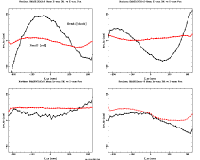 | |
| Figure 15 |
The approximate galactic coordinates of each 2MASS source are supplied in the PSC (glon, glat). These coordinates are provided to a precision of only three decimal places (3.6´´), though. This is done because the galactic coordinate system is not the astrometric reference system of 2MASS, and there is currently an ambiguity in the appropriate way to convert J2000 ICRS coordinates to the galactic system. The PSC galactic coordinates were derived by precessing J2000.0 coordinates to B1950, then using the rotation transformations into the lII,bII system. This transformation method produces galactic coordinates that can differ by up to 0.4´´ from those, e.g., produced using the direct J2000-to-galactic transformations, proposed by Murray (1989, AsAp, 218, 325).
Because there is not currently an IAU-standard for the ICRS-to-galactic transformation, we provide approximate galactic coordinates to facilitate coarse searches only.
xiv. Tile Overlap Regions
Sources that lie in the overlapping regions between 2MASS Survey Tiles
(see III.2b) may be detected
more than once during Survey observations. To insure the
uniformity of depth, the PSC was constructed by selecting
only one apparition of multiply-detected (or "duplicate") sources,
rather than averaging measurements.
Because faint sources near the detection level of the measurements
have more than one chance to be detected in the overlap regions,
the effective sensitivity is slightly enhanced in those regions.
The full PSC contains sources that were detected on only
a subset of all possible Tiles
regardless of their location in the overlap strip. However, the
high-reliability Catalog subset of the PSC contains
only those non-multiply-detected sources that satisfy a purely
geometric selection that removes the sensitivity bias.
The use_src and dup_src
values in each source record provide a guide for understanding
the process that selected the apparitions for the PSC and high-reliability
Catalog (cf. V.4).
The duplicate source resolution process
for the PSC began by positionally correlating
sources from all overlapping Tiles, using a match
radius of 2´´. All sources that had matching counterparts in
overlapping Tiles had the dup_src value set to
Sources in the overlapping regions that were not detected on all
possible Tiles
were treated specially to insure uniformity of sensitivity in
the high-reliability Catalog subset of the PSC.
A source that was missing one or more possible apparitions
was assigned use_src="1" only if it was closer to its
respective Tile center than the apparitions in the overlapping
Tiles would have been to their Tile centers, had they been detected.
This selection is based solely on geometry and not on source brightness,
so it minimizes the non-uniformity of sensitivity in the Tile overlaps.
Non-matching sources in the overlap regions that are farther
from their Tile centers than their "virtual-duplicate" counterparts
are included in the PSC, but have use_src="0".
Sources were included in the PSC if they had use_src="1"
OR (use_src="0" AND dup_src="0"). The requirements for
a source to be part of the highly-reliable, uniform Catalog
subset of the PSC is use_src="1".
In addition to faint sources toggling above and below
the 2MASS detection thresholds, there are several other reasons
a source may fail to be detected on all possible Tiles in which
it was observed. Some, but not all of these are reason
to treat sources with use_src=0 and dup_src=0 with
some caution.
xv. Solar System Objects
No attempt was made to remove non-inertially fixed sources
from the PSC. However, sources that are at the positions of
known asteroids, comets, planets or planetary satellites
at the time of the observations are flagged by having mp_flg="1".
These are positional associations and are not necessarily identifications.
Therefore, they remain in the PSC. Some fraction of the putative
detections are not valid, but are chance superpositions of the predicted
positions with background sources. This is particularly likely at low
Galactic latitudes, where the density of background stars is large.
See IV.9 for more details.
xvi. Optical Associations
All PSC sources were positionally correlated with
the Tycho 2 and
USNO-A2.0
optical catalogs. 2MASS sources that have optical catalog counterparts
within ~5´´ of the PSC position have listed for
convenience the optical catalog identifier (a="T" or "U"),
blue and visual-or-red magnitudes,
the 2MASS/optical position separation (dist_opt) and
position angle (phi_opt) information listed in the PSC source
record, for convenience. Matches with the Tycho 2 catalog
take precedence over the USNO-A2.0 matches in the PSC listing.
It is stressed that these are positional associations, and
not necessarily identifications. The positional accuracy of 2MASS and
the optical catalogs is sufficiently high that inertial sources should
have positions that match to within ~1´´. Optical associations
with separations dist_opt >1´´ are either proper motion
candidates, or possible cases of chance alignments with the IR
sources.
The optical magnitudes listed for the optical associations
in the PSC are derived from the Tycho 2 and USNO-A2.0 values.
In the case of Tycho 2 associations, the optical magnitudes listed
are Johnson B and V magnitudes and are derived
from the Tycho blue (BT) and visual (VT)
magnitudes using the transformations given by
(Høg et al. 2000):
V = VT - 0.090*(BT - VT)
For USNO-A2.0 associations, the optical magnitudes are
the photographic blue and red magnitudes taken explicitly from
the USNO-A2.0 Catalog.
Incorrect "a" Values for Optical Associations with dist_opt
A software error in setting the optical catalog identifier flag,
a, resulted in an incorrect
value of a="0" being assigned to optical associations that have
dist_opt
Missed Optical Associations Near the Equatorial Poles
An error in the positional correlation procedure between 2MASS and
USNO-A2.0 sources resulted in associations being systematically
missed in the vicinity of the north and south equatorial poles.
In Figure 16 is shown the
fraction of bright, three-band 2MASS PSC sources without
optical counterparts
(nopt_mchs=0) plotted
as a function of declination within 20° of the north equatorial pole.
The fraction of PSC sources without reported counterparts
increases rapidly and monotonically with proximity to the pole for
declinations > 86°. Optical associations for PSC
sources near the south equatorial pole exhibit identical behavior.
An independent correlation between 2MASS and USNO-A2.0 sources in the
vicinity of the poles shows that most PSC sources do have
USNO-A2.0 counterparts within 5´´. Furthermore,
good agreement between 2MASS and USNO-A2.0 positions near the poles, and
the analysis of 2MASS astrometric accuracy
(e.g., VI.6a.ii) indicate that there
is no evidence for systematic problem with 2MASS or USNO-A2.0 positions
near the poles. Therefore, the
apparent increase in fraction of sources without optical
counterparts shown in Figure 16 is an artifact of the correlation
processing.
For sources with |dec|>86°, the
optical association information is not reliable. The absence of optical
association data in the PSC record does not necessarily mean that there
is not an optical source within 5´´
of the 2MASS position.
use_src and dup_src
 1.
Sources without duplicate apparitions have dup_src=0.
For each group of matched sources, the apparition
that fell farthest from its respective Tile edge was selected
for the PSC. The selected source was assigned use_src=1.
Duplicate sources that were not closest to their Tile centers were
assigned use_src=0. Sources not in Tile overlap
regions have use_src=1 and dup_src=0.
1.
Sources without duplicate apparitions have dup_src=0.
For each group of matched sources, the apparition
that fell farthest from its respective Tile edge was selected
for the PSC. The selected source was assigned use_src=1.
Duplicate sources that were not closest to their Tile centers were
assigned use_src=0. Sources not in Tile overlap
regions have use_src=1 and dup_src=0.
Other Reasons That Sources May Not Be Detected in All Possible Tiles
B-V = 0.850*(BT - VT)
 5´´
5´´
 5´´.
There are 361,663 sources in the full PSC with this error. These objects
can be identified as having a="0" and non-null values in the
other optical association fields:
dist_opt,
phi_opt,
b_m_opt, and
vr_m_opt.
The optical catalog identifier, a, should not
be used as the only test for optical counterparts in PSC sources.
5´´.
There are 361,663 sources in the full PSC with this error. These objects
can be identified as having a="0" and non-null values in the
other optical association fields:
dist_opt,
phi_opt,
b_m_opt, and
vr_m_opt.
The optical catalog identifier, a, should not
be used as the only test for optical counterparts in PSC sources.
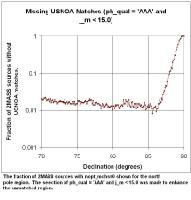 |
| Figure 16 |
[Last Updated: 2009 September 7; by R. Cutri and M. Skrutskie]